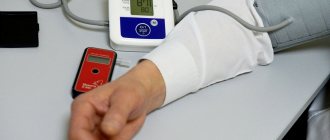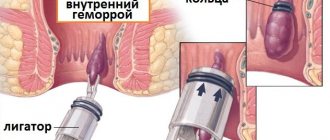Arterial hypertension – lifelong medication use?
Perhaps the majority of patients seen by a cardiologist are patients with high blood pressure - arterial hypertension (AH). Some of them had their blood pressure rise for the first time due to a stressful situation, some have been taking medications for a long time, but, as a rule, few have a complete understanding of their disease, and most importantly, how to live with it correctly and effectively treat it .
In a healthy person, blood pressure changes throughout the day depending on the level of stress (physical, mental, etc.), but in general these fluctuations do not exceed the so-called physiological norm, which supports the normal functioning of the body. For an adult, blood pressure is considered normal no higher than 140/90 mmHg. Art. And in some cases, for example, in the presence of diabetes mellitus, kidney disease, the pressure should be even lower at the level of 130/80 - 120/70 mm Hg. Art., which helps prevent the progression of these diseases and the development of complications. The state of the nervous system, heart and blood vessels plays an important role in maintaining blood pressure within optimal limits. With hypertension, the heart works overload, pumping an additional volume of blood. Over time, this leads to increased resistance from the vessels, which narrow under conditions of constant overload. The walls of the arteries thicken and harden, losing their elasticity. With the long-term existence of hypertension, the load on the vessels becomes unbearable, which can lead to degenerative changes in their wall, with the development of narrowing or pathological expansion, and even rupture of the vessel can occur. If this complication occurs in a vital organ (heart, brain), then it can result in myocardial infarction or cerebral hemorrhage (stroke) . But, despite this danger, the insidiousness of hypertension is that it can be completely asymptomatic for a long time.
The diagnosis of hypertension is usually not made after a single blood pressure measurement, unless the readings are too high, for example, over 170-180/105-110 mm Hg. Art. Typically, a series of measurements are taken over a period of time to completely eliminate random fluctuations and inaccuracies. It is also necessary to take into account the circumstances during which blood pressure measurements are taken. As a rule, blood pressure increases under stress, after drinking strong coffee or smoking a cigarette.
About 1/3 of the adult population has a persistent increase in blood pressure above 140/90 millimeters of mercury. 2/3 of those who suffer from hypertension do not know about their disease, and those who know often do not give it due importance (especially if the numbers are not so high, about 160/100 mm Hg), until headaches, heart pain, shortness of breath, arrhythmia, and swelling will not occur.
An interesting fact is that in a doctor’s office, when measuring blood pressure, the readings can be higher than at rest at home. This effect is called "white coat hypertension" and is caused by the patient's fear of the disease or the doctor. In addition to measuring blood pressure, the doctor usually checks for changes in other organs, especially if the pressure readings are at high levels.
If the blood pressure in an adult does not exceed 140/90 mm. rt. Art., then re-measurement is usually carried out no earlier than a year later. In patients whose blood pressure is between 140/90 and 160/100, repeated measurements are taken after a short period of time to confirm the diagnosis.
A high diastolic (bottom) pressure, such as 110 or 115 mmHg, indicates the need for immediate treatment.
Hypertension is one of the most common diseases. In developed countries, 10% of the adult population and about 60% of people over 65 years of age have high blood pressure. Unfortunately, no more than 30% of these people know about their illness, regularly receive therapy and follow the doctor’s recommendations. Unlike a number of diseases that you can “get over,” hypertension, as a rule, is a chronic, lifelong condition.
Arterial hypertension is most often primary in nature and is a symptom of hypertension. Less commonly, high blood pressure is secondary and is a sign of diseases of various organs (kidneys, blood vessels, etc.). Each of these diseases requires special treatment, which is why any increase in blood pressure requires consultation with a cardiologist.
In older people, a special type of hypertension sometimes occurs, so-called “isolated systolic hypertension.” In this case, systolic pressure readings are equal to or exceeding 140 mmHg, and diastolic pressure readings remain below 90 mmHg. This type of hypertension is a dangerous risk factor for the development of strokes and heart failure. Often, patients seek help only when the diastolic pressure, in their opinion, becomes too low - 50-60 mm Hg. Art. Sometimes this can be a sign of heart disease, but more often it is associated with age-related changes in the vascular wall, and it is very important to find drugs that will reduce the gap between systolic and diastolic pressure numbers, which in turn reduces the risk of stroke and heart failure .
In cases where routine and dietary measures do not allow adequate control of blood pressure, additional (and not instead) medications are prescribed. Today their list is quite impressive. Often, when a patient seeks help with complaints of high blood pressure despite taking prescribed medications, you can see that the medications were chosen correctly and are suitable for the patient for long-term use, but their dosages are inadequate. In cardiology, there is the concept of an effective dose - that is, one at which one can count on the manifestation of the desired effect. And if you take the same drug in halves or fours, and not just 2, but once a day, and often not even every day, then there is no need to talk about any hypotensive, much less therapeutic, effect of the drug. When prescribing one or more drugs, the cardiologist takes into account the level of blood pressure, the severity of hypertension, the individual daily blood pressure profile, the main risk factors or causes of arterial hypertension, the severity of target organ damage, the presence of concomitant diseases, and the interaction of drugs with each other and with other medications taken. , the possibility of developing side effects. Therefore, it is absolutely unacceptable for a patient to change doctor’s prescriptions, drug doses, frequency of administration, or discontinue one or another drug on their own. If, when taking a prescribed combination of antihypertensive drugs, the patient notices the occurrence of any side effects, the pressure does not decrease or, on the contrary, decreases excessively, it is necessary to discuss this with the attending physician, who, having understood the reasons, will adjust your prescriptions.
The role of the patient in the treatment of arterial hypertension cannot be underestimated. The effectiveness of treatment measures largely depends on how ready he is, in accordance with the doctor’s recommendations, to actively and consistently fight and, if possible, eliminate his risk factors. Dealing with risk factors means stopping smoking, limiting alcohol consumption, regularly taking recommended medications and monitoring their effect on blood pressure by recording measurements in a special diary.
Effective control of blood pressure should be considered if, as a result of lifestyle modifications, elimination of risk factors and bad habits, or taking antihypertensive drugs, it is possible to maintain blood pressure levels below 140/90 mmHg. Art., and for patients with diabetes mellitus, if possible, below 130/80 mmHg. Art. Achieving a target blood pressure level helps reduce the relative risk of developing fatal and non-fatal conditions/diseases, compared with patients who are not treated or are taking ineffective combinations. Each patient with hypertension needs to reduce excess weight, lead an active lifestyle, stop smoking, limit alcohol consumption (10 - 20 g for women, 20 - 30 for men in terms of pure ethanol), regularly take recommended medications and monitor their effect on blood pressure, enter blood pressure measurement data and other information necessary for the doctor in a special blood pressure self-monitoring diary.
If blood pressure exceed the specified level, then you should discuss with your doctor the possible reasons for the lack of effectiveness of the treatment. Among them:
- in blood pressure has not been identified
- Failure to comply with lifestyle modification recommendations
- Irregular use of antihypertensive drugs
- Inadequate antihypertensive therapy
As practice shows, if the patient trusts his doctor, with competent interaction between the doctor and the patient, in most cases it is possible to control this terrible disease.
What if you are already taking 3 or more medications and your blood pressure has not stabilized at your target level? This form of hypertension is classified as resistant.
Resistant hypertension is a condition in which blood pressure remains above target despite taking a combination of three or more antihypertensive drugs. Uncontrolled hypertension is not synonymous with resistant hypertension. Uncontrolled hypertension is caused by insufficient secondary control of blood pressure due to non-compliance with treatment regimen or true resistance to therapy. The criterion for refractory arterial hypertension is a decrease in systolic blood pressure by less than 15% and diastolic blood pressure by less than 10% from the initial level against the background of rational therapy using adequate doses of three or more antihypertensive drugs.
The lack of adequate blood pressure in more than 2/3 of patients is due to non-compliance with the treatment regimen - pseudo-refractoriness. Another most common and easily eliminated cause of this phenomenon is excessive consumption of table salt. Reasons that are much more difficult to cope with include obesity, alcohol abuse, the use of certain medications, breathing disorders and stopping during sleep, and kidney disease.
The following factors are associated with an increased risk of developing resistant hypertension: older age, high initial blood pressure, obesity, excessive consumption of table salt, chronic kidney disease, diabetes mellitus, left ventricular hypertrophy, female gender. The cause of true refractoriness in hypertension is volume overload associated with inadequate use of diuretics.
What's the solution?
Usually, in the case of resistant (refractory) hypertension, doctors continue to increase the doses of drugs taken by the patient to the maximum tolerated or add sequentially a fourth, fifth, and sometimes a sixth drug from other groups. Patients react to this differently. Many people stop trusting the doctor, some refuse to take medications altogether, because they do not notice any difference between their blood pressure while taking handfuls of medications and without them.
Of course, this decision is fundamentally wrong. In order to avoid progressive target organ damage and serious complications in the future, it is necessary to continue taking medications even if it is not possible to achieve the target blood pressure level. But no one will deny that the use of a multicomponent combination of drugs significantly increases the risk of side effects and unpredictable drug interactions.
What can modern medicine offer in this case? It turns out there is a way out.
Soon in our clinic we will be able to offer a non-surgical method for correcting blood pressure by denervation of the renal arteries. A new procedure, catheter-based renal denervation of the renal arteries, helps control high blood pressure by destroying some of the nerve fibers located in the wall of the renal arteries.
As often happens, the idea of denervation is not new, it is a well-forgotten old thing. Surgeons have long known that excision of the sympathetic nerve fibers responsible for maintaining blood pressure resulted in a decrease in blood pressure. But the procedure could not be used to treat hypertension, since it was accompanied by high operative mortality and long-term complications such as severe hypotension when moving to a vertical position, up to loss of consciousness, dysfunction of the intestines and pelvic organs. But this happens because the sympathetic stimulation of the kidneys and other organs is completely turned off, which leads to an imbalance of nervous regulation. Since the sympathetic nerve fibers innervating the kidney pass directly into the wall of the main renal artery and are adjacent to it, using catheter radiofrequency ablation (RFA) targeted destruction of fibers in the renal arteries will not lead to disruption of the innervation of the abdominal organs and lower extremities. In addition, by destroying only a small part of the nerve endings in the renal arteries, the kidneys are not deprived of nervous regulation. THE CAUSE OF RESISTANT HYPERTENSION IS EXCESSIVE SYMPATHETIC ACTIVITY OF THE KIDNEYS. And catheter RFA allows you to eliminate this excess activity. HYPERTENSION BECOME CONTROLLED.
The introduction of this procedure into our practice is based on a study published in the famous journal Lancet, which showed the safety and effectiveness of the technique, which allows us to achieve a lasting reduction in blood pressure up to 30 mm. rt. Art. from the initial level.
For this treatment, a radiofrequency catheter from Ardian is used, which is inserted through a puncture in the femoral artery. Next, the catheter is passed under X-ray control into the renal artery. Through the tip of the catheter, radiofrequency energy is dosed around the circumference at 4-5 points of the renal arteries. The procedure takes about 40 minutes, after which the catheter is removed. The patient's hospital stay is 24 hours. The condition for the procedure is normal kidney function. But the most striking thing about the procedure is that over time, the therapeutic effect not only does not decrease, but, on the contrary, the blood pressure of the majority gradually and steadily normalizes.
Currently, renal denervation is used only in patients with resistant hypertension. This should lead to approximately a 50% reduction in hypertension-related complications and mortality. This does not mean that medications are no longer needed. Patients will still likely need to take high blood pressure medications, but the number of medications needed to keep blood pressure at target levels will be significantly reduced.
What are the side effects of RFA of the renal arteries?
To date, no serious complications of catheter-based renal denervation have been reported worldwide. The procedure was accompanied by moderate abdominal pain, which was relieved by intravenous analgesics and sedatives. Only one patient had damage to the renal artery by the catheter before RFA, which was corrected by implantation of a stent. The most common complication in a small number of patients was pain and swelling in the groin area. No deterioration in renal function was noted.
Who needs renal denervation?
Denervation of the renal arteries
- Cost: 250,000 rub.
- Duration: 20-30 minutes
- Hospitalization: 1 day in hospital
More details
This intervention is indicated for patients with resistant hypertension, i.e. with a persistent increase in systolic (upper) blood pressure higher than 160 mm Hg. Art., despite the use of 3 or more antihypertensive drugs, including a diuretic. This is especially indicated if the combination of drugs is poorly tolerated or if there are side effects. In this case, patients must be preliminarily examined, and possible secondary causes of arterial hypertension (for example, diseases of the adrenal glands) must be reliably excluded. At the preliminary stage, it is necessary to conduct a computed tomography scan of the renal arteries to clarify the anatomical features of the vessels.
If you have high blood pressure , contact the cardiologists of our center. They will definitely help you.
Association between hypertension and CKD
Arterial hypertension and CKD have close and complex relationships with each other. Hypertension is often considered both a cause and a consequence of chronic kidney disease. It is widespread and rarely controlled. The complex interaction of these dangerous pathologies with each other provokes unfavorable outcomes of diseases of the heart, blood vessels and brain.
The pathophysiological mechanisms of increased pressure in renal pathology are complex and are the consequences of many factors such as:
- decrease in kidney cell mass;
- delays in sodium excretion from the body;
- increased activity of the sympathetic nervous system;
- increase in extracellular volume;
- activation of hormonal activity.
Patients with CKD often have high blood pressure with high risks. Hypertension may have:
- hidden form;
- resistant course.
Sometimes it occurs at night.
Hypertension and CKD should be carefully studied to slow the development of cardiac and renal dysfunction.
Diagnostics
The “Clinic of Modern Medicine” has a powerful modern laboratory and technical base, which allows you to quickly conduct a comprehensive study and promptly obtain reliable results. The following studies will help determine whether hypertension has a renal component:
- urine tests (general, according to Nechiporenko, bacterioscopy of urinary sediment),
- blood test (general, urea, creatinine),
- Ultrasound, MRI of the adrenal glands,
- excretory urography,
- angiography of the renal arteries,
- radioisotope radiography,
- kidney biopsy.
Differential diagnosis makes it possible to accurately identify pathology, determine the type of hypertension, its stage and severity, which allows the doctor to select the most effective treatment regimen.










